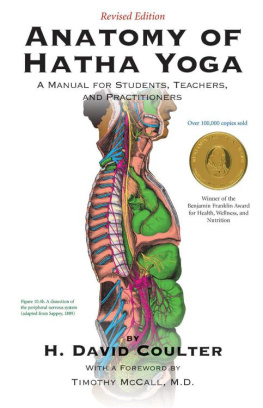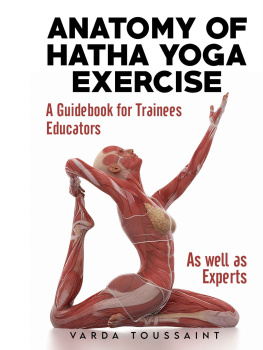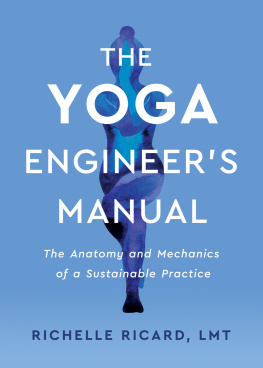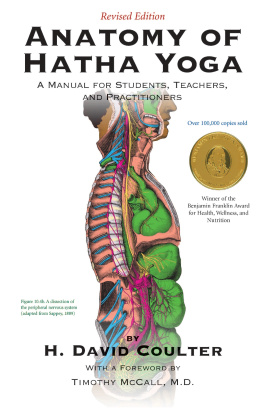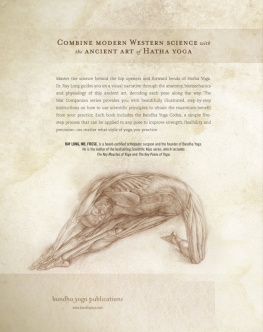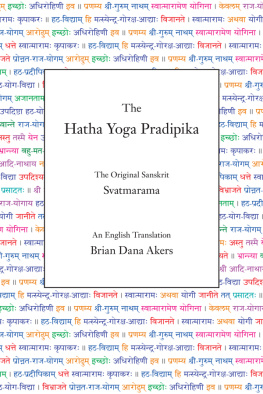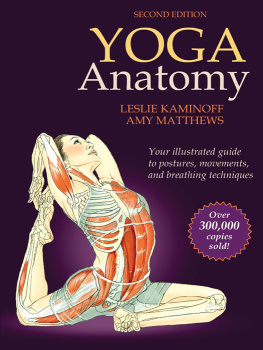ANATOMY
OF
HATHA YOGA
ANATOMY
OF
HATHA YOGA
A Manual for Students, Teachers, and Practitioners
by
H. David Coulter
Foreword
by
Timothy McCall, M. D.
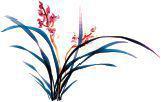
Body and Breath
Honesdale, PA, USA
Text and illustrations 2001 by H. David Coulter
Foreword 2001 by Timothy McCall
Body and Breath, Inc., 2114 Ames Hill Rd., Marlboro, VT 05344 USA
2017 2016 2015 2014 2013 2012 2011 2010 17 16 15 14 13 12 11 10 9 8
PRECAUTIONARY NOTE: This is not a medical text, but a compendium of remarks concerning how anatomy and physiology relate to hatha yoga. Any medical questions regarding contraindications and cautions or any questions regarding whether or not to proceed with particular practices or postures should be referred either to health professionals who have an interest in medical problems associated with exercise, stretching, and breathing, or to hatha yoga teachers who have had experience working with medical problems in a therapeutic setting supervised by health professionals.
All rights reserved. With certain exceptions enumerated below, no part of this book may be reproduced, stored in a retrieval system, or transmitted in any form or by any meanselectronic, mechanical, photocopying, recording, or otherwisewithout written permission from the publisher. There are three exceptions. First: brief quotations of up to words that are embodied in critical articles and reviews can be used freely so long as they are properly acknowledged. Second: blanket permission is granted for institutional and individual photocopying, properly acknowledged, of up to one hundred copies totaling no more than 25,000 words for each copy with accompanying illustrations (approximately one chapter), or alternatively, a series of extracts from the entire book totaling no more than 25,000 words, for purposes of teaching or for research and private study, excepting that no deletions, alterations, or exclusions within individual pages are permitted. For example: cutting and pasting of illustrations for student syllabi is expressly forbidden. Only individual pages in their entirety are to be photocopied, including text (if any) and all running heads, captions, and labels that are incorporated within each page. Third: permission for scanning of text, halftones, anatomical drawings, charts, and tables (either in isolation or altered as desired) is granted only for trials of electronic or hard copy publishing layouts; permission must be sought from the publisher (Body and Breath Inc.) to use such illustrations for any kind of electronic or mechanical transmission or in other publications. Printed in China.
Library of Congress Cataloging-in-Publication Data
Coulter, H. David (Herbert David), 1939
Anatomy of Hatha Yoga : a manual for students, teachers, and practitioners / by
H. David Coulter ; foreword by Timothy McCall.
p. cm.
Includes bibilographical references and index. eISBN 9780970700629 1. Yoga, HathaPhysiological aspects. 2. Human mechanics. 3. Human anatomy.
I. Title.
RA 781.7.C685 2001
613.7046dc21
2001025691
To my parents, who guided me lovingly, watched my life with joy and enthusiasm, supported my academic and personal interests, and always thought the best of me.
Why do you never find anything written about that idiosyncratic thought you advert to, about your fascination with something no one else understands? Because it is up to you. There is something you find interesting, for a reason hard to explain. It is hard to explain because you have never read it on any page; there you begin. You were made and set here to give voice to this, your own astonishment.
Annie Dillard, in The Writing Life
CONTENTS
FOREWORD
H atha yoga. Its teachers and serious students are convinced of its power to build strength and confidence, to improve flexibility and balance, and to foster spiritual peace and contentment. And beyond its attributes as preventive medicine, many of us also believe in the power of yoga to heal, to aid in recovering from everything from low back strain to carpal tunnel syndrome and to help cope with chronic problems like arthritis, multiple sclerosis and infection with the human immunodeficiency virus (HIV).
But despite the recent boom in yogas popularity, most scientists and physicians have been slow to embrace this discipline. To many of them perhaps, it seems like a mystical pursuit, a quasi-religion with little basis in the modern world of science. In a medical profession now itself dominated by a near religious reverence for the randomized, controlled study, knowledge acquired through thousands of years of direct observation, introspection, and trial and error may seem quaint.
But as the West has slowly opened in the past decades to Eastern, experientially based fields like acupunctureas part of a greater acceptance of alternative medicine in generalyoga has begun to stake its claim. Concepts like prana or chi, however, are not warmly received by skeptical scientists. To win them over you need to provide the kind of evidence they buy. Studies. Preferably published in peer-review journals. And you need to propose mechanisms of action that conform with science as they understand it.
A significant breakthrough was provided by Dr. Dean Ornish, a California-based cardiologist who interrupted his college years to study with Sri Swami Satchidananda. His work, published in 1990 in the prestigious British medical journal the Lancet , showed that a program that combines hatha yoga with dietary changes, exercise, and group therapy can actually reverse blockages in the hearts main arterieswhich doctors used to think wasnt possible.
In 1998, research led by Marian Garfinkel of the Medical College of Pennsylvania and published in the Journal of the American Medical Association found that Iyengar yoga could effectively reduce the symptoms of carpal tunnel syndrome, a malady of near epidemic proportions in this computer age. Of note, Garfinkels study lasted only eight weeks, and yet the intervention proved efficacious. Serious yoga practitioners realize of course that although some benefit may be noticed after even a single class, yogas most profound effects accrue over yearseven decadesnot weeks. Yoga is indeed powerful medicine but it is slow medicine.
More studies will be needed to convince the medical establishment, but that research could also be slow in coming. Funding is a perennial problem. Unlike the situation with, say, pharmaceuticals, there is no private industry to bankroll the scientific investigation of hatha yoga. Given the incredible cost of long-range studieswhich are more likely to demonstrate effectivenessI suspect that were unlikely to see any time soon the kind of overwhelming proof that skeptical scientists want. This presents a philosophical question: When you have an intervention which appears safe and effectiveand when its side effects are almost entirely positiveshould one wait for proof before trying it? This value judgment lies at the heart of the recent debate over many traditional healing methods.
Ironically, though, even within the world of alternative medicine yoga seems under-appreciated. Two years ago, I attended a four-day conference on alternative medicine sponsored by Harvard Medical School. A wide range of topics from herbs to prayer to homeopathy were covered in detail. Yet in the dozens of presentations I attended, yoga was mentioned just once: In a slide that accompanied the lecture on cardiovascular disease, yoga was one of several modalities listed under Other Stress Reduction Techniques. Yoga is certainly a stress reduction device but to reduce it to just that misses so much.
Next page
